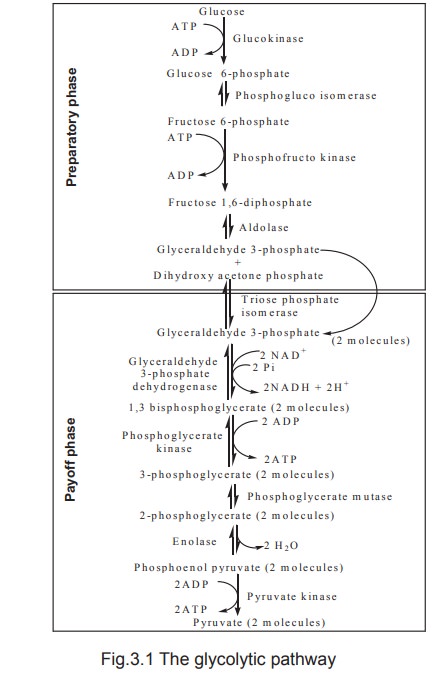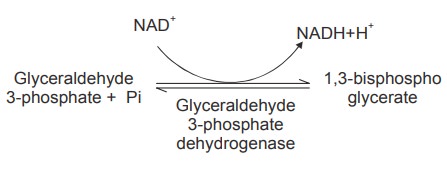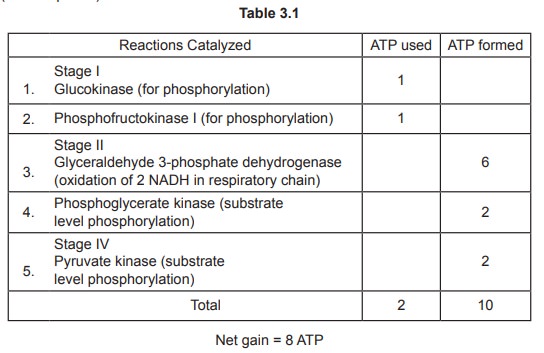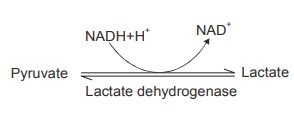Chapter: Biochemistry: Carbohydrate Metabolism
Carbohydrate as a source of energy
Carbohydrate as a source of energy
The major function of carbohydrate in metabolism
is to serve as fuel and get oxidised to provide energy for other metabolic
processes. The metabolic intermediates are used for various biosynthetic
reactions. For this purpose, carbohydrate is utilized by the cells mainly in
the form of glucose. A major part of dietary glucose is converted to glycogen
for storage in liver. Glucose is degraded in the cell by way of a series of
phosphorylated intermediates mainly via two metabolic pathways.
1.
Glycolysis
2.
Tricarboxylic
acid cycle
Glycolysis
Oxidation of glucose to pyruvate is called
glycolysis. It was first described by Embden-Meyerhof and Parnas. Hence it is
also called as Embden-Meyerhof pathway.
Glycolysis occurs virtually in all tissues.
Erythrocytes and nervous tissues derive the energy mainly from glycolysis. This
pathway is unique in the sense that it can proceed in both aerobic (presence of
O2) and anaerobic (absence of O2) conditions. All the
enzymes of glycolysis are found in the extra mitochondrial soluble fraction of
the cell, the cytosol.
1. Reactions of glycolytic pathway
Series of reactions of glycolytic pathway which
degrades glucose to pyruvate are represented below. The sequence of reactions
occurring in glycolysis may be considered under four stages.
Stage I
This is a preparatory
phase. Before the glucose molecule can be split, the rather asymmetric
glucose molecule is converted to almost symmetrical form, fructose
1,6-diphosphate by donation of two phosphate groups from ATP.

1. Uptake of glucose by cells and its phosphorylation
Glucose is freely permeable to liver cells,
intestinal mucosa and kidney tubules where glucose is taken up by 'active'
transport. In other tissues insulin facilitates the uptake of glucose. Glucose
is phosphorylated to form glucose 6-phosphate. The enzyme involved in this
reaction is glucokinase. This reaction is irreversible.

2. Conversion of glucose 6-phosphate to fructose 6-phosphate
Glucose 6-phosphate is converted to fructose
6-phosphate by the enzyme phosphogluco isomerase.

3. Conversion of fructose 6-phosphate to fructose 1,6 diphosphate
Fructose 6-phosphate is phosphorylated
irreversibly at 1 position catalyzed by the enzyme phosphofructokinase to
produce fructose 1,6-diphosphate.

Stage II
1. Actual splitting of fructose 1,6 diphosphate
Fructose 1,6 diphosphate is split by the enzyme
aldolase into two molecules of triose phosphates, an aldotriose-glyceraldehyde
3-phosphate and one ketotriose - dihydroxy acetone phosphate. The reaction is
reversible. There is neither expenditure of energy nor formation of ATP.

2. Interconvertion
of triose phosphates Both
triose phosphates are interconvertible

Stage III
It is the energy yielding stage. Reactions of
this type in which an aldehyde group is oxidised to an acid are accompanied by
liberation of large amounts of potentially useful energy.
1. Oxidation of glyceraldehyde 3-phosphate to 1,3-bisphosphoglycerate
Glycolysis proceeds by the oxidation of
glyceraldehyde 3-phosphate to form 1,3-bisphosphoglycerate. The reaction is
catalyzed by the enzyme glyceraldehyde 3-phosphate dehydrogenase

2. Conversion of 1,3-bisphosphoglycerate to 3-phosphoglycerate
The reaction is catalyzed by the enzyme
phosphoglycerate kinase. The high energy phosphate bond at position - 1 is
transferred to ADP to form ATP molecule.

Stage IV
It is the recovery of the phosphate group from
3-phosphoglycerate. The two molecules of 3-phosphoglycerate, the end-product of
the previous stage, still retains the phosphate group, originally derived from
ATP in Stage I.
1. Conversion of 3-phosphoglycerate to 2-phosphoglycerate.
3-phosphoglycerate formed by the above reaction is converted to 2-phosphoglycerate, catalyzed by the enzyme phosphoglycerate mutase.

2. Conversion of 2-phosphoglycerate to phosphoenol pyruvate
The reaction is catalyzed by the enzyme enolase,
the enzyme requires the presence of either Mg2+ or Mn2+ ions for activity.

3. Conversion of phosphoenol pyruvate to pyruvate
Phosphoenol pyruvate is converted to pyruvate,
the reaction is catalysed by the enzyme pyruvate kinase. The high energy
phosphate group of phosphoenol pyruvate is directly transferred to ADP,
producing ATP. The reaction is irreversible.

Summary of glycolysis
During glycolysis NAD+ is reduced to NADH. At
the same time, glyceraldehyde 3-phosphate is oxidized to
1,3-bisphosphoglycerate. To conserve the coenzyme NAD+, NADH must be
reoxidized. Under anaerobic conditions this is done when pyruvic acid is
converted to lactic acid. In the presence of oxygen, NADH, can be oxidized to
NAD+ with the help of the respiratory enzymes.
Energy yield per glucose molecule oxidation
During glycolysis ATP molecules are used and
formed in the following reactions (aerobic phase).

Anaerobic phase
In the absence of O2, reoxidation of
NADH at glyceraldehyde 3-phosphate dehydrogenase stage cannot take place in
respiratory chain. But the cells have limited coenzyme. Hence to continue the
glycolysis NADH must be reoxidized to NAD+. This is achieved by reoxidation of
NADH by conversion of pyruvate to lactate (without producing ATP).

It is to be noted that in the reaction catalyzed
by glyceraldehyde 3-phosphate dehydrogenase, therefore, no ATP is produced.
In the anaerobic phase oxidation of one glucose
molecule produces 4 - 2 = 2 ATP.
Related Topics